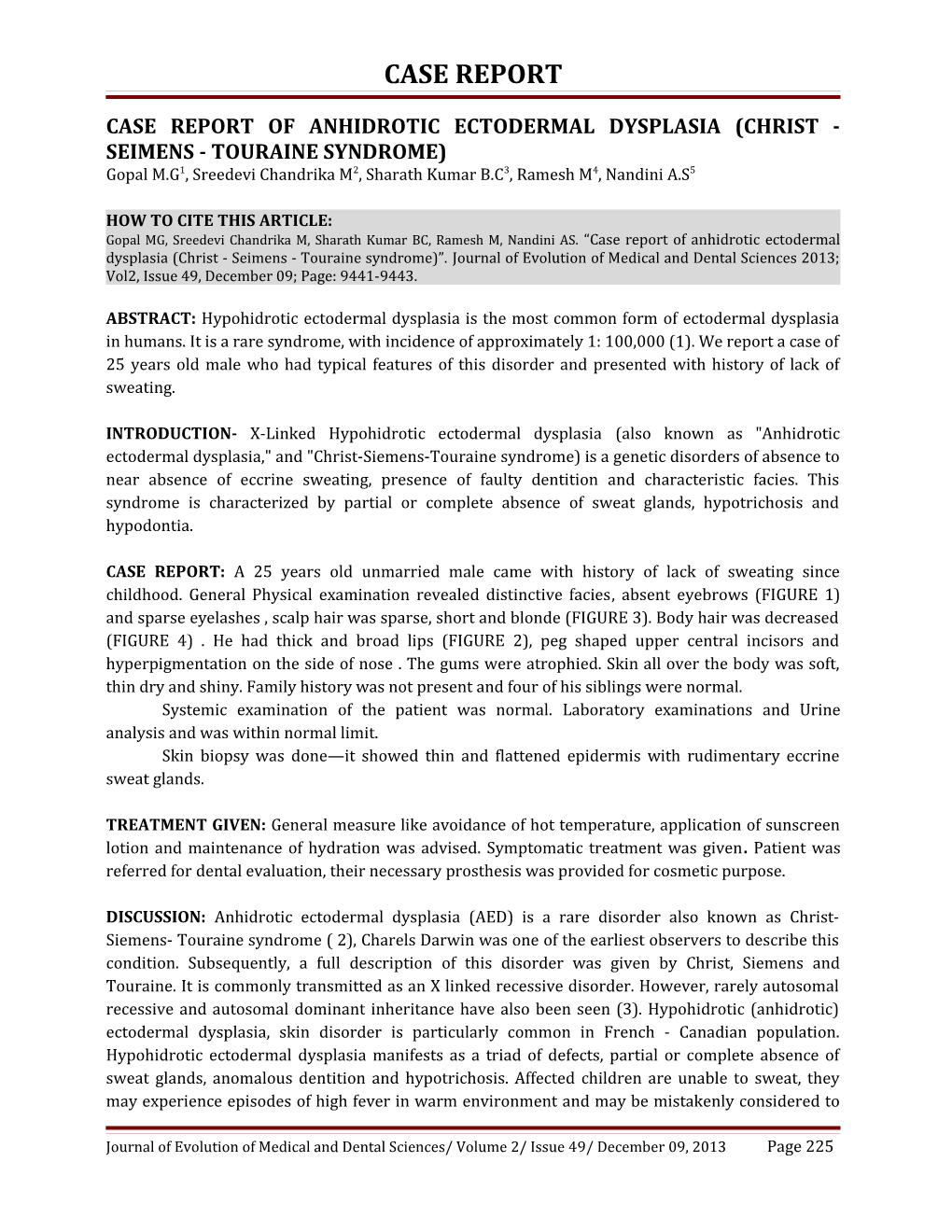CASE REPORT
CASE REPORT OF ANHIDROTIC ECTODERMAL DYSPLASIA (CHRIST - SEIMENS - TOURAINE SYNDROME)
Gopal M.G1, Sreedevi Chandrika M2, Sharath Kumar B.C3, Ramesh M4, Nandini A.S5
HOW TO CITE THIS ARTICLE:
Gopal MG, Sreedevi Chandrika M, Sharath Kumar BC, Ramesh M, Nandini AS. “Case report of anhidrotic ectodermal dysplasia (Christ - Seimens - Touraine syndrome)”.Journal of Evolution of Medical and Dental Sciences 2013; Vol2, Issue 49, December 09; Page: 9441-9443.
ABSTRACT: Hypohidrotic ectodermal dysplasia is the most common form of ectodermal dysplasia in humans. It is a rare syndrome, with incidence of approximately 1: 100,000 (1). We report a case of 25 years old male who had typical features of this disorder and presented with history of lack of sweating.
INTRODUCTION-X-Linked Hypohidrotic ectodermal dysplasia (also known as "Anhidrotic ectodermal dysplasia," and "Christ-Siemens-Touraine syndrome) is a genetic disorders of absence to near absence of eccrine sweating, presence of faulty dentition and characteristic facies. This syndrome is characterized by partial or complete absence of sweat glands, hypotrichosis and hypodontia.
CASE REPORT: A 25 years old unmarried male came with history of lack of sweating since childhood. General Physical examination revealed distinctive facies, absent eyebrows (FIGURE 1) and sparse eyelashes , scalp hair was sparse, short and blonde (FIGURE 3). Body hair was decreased (FIGURE 4) . He had thick and broad lips (FIGURE 2), peg shaped upper central incisors and hyperpigmentation on the side of nose . The gums were atrophied. Skin all over the body was soft, thin dry and shiny. Family history was not present and four of his siblings were normal.
Systemic examination of the patient was normal.Laboratory examinations and Urine analysis and was within normal limit.
Skin biopsy was done—it showed thin and flattened epidermis with rudimentary eccrine sweat glands.
TREATMENT GIVEN: General measure like avoidance of hot temperature, application of sunscreen lotion and maintenance of hydration was advised. Symptomatic treatment was given. Patient was referred fordental evaluation, their necessaryprosthesis was provided for cosmetic purpose.
DISCUSSION: Anhidrotic ectodermal dysplasia (AED) is a rare disorder also known as Christ-Siemens- Touraine syndrome ( 2), Charels Darwin was one of the earliest observers to describe this condition. Subsequently, a full description of this disorder was given by Christ, Siemens and Touraine. It is commonly transmitted as an X linked recessive disorder. However, rarely autosomal recessive and autosomal dominant inheritance have also been seen (3). Hypohidrotic (anhidrotic) ectodermal dysplasia, skin disorder is particularly common in French - Canadian population. Hypohidrotic ectodermal dysplasia manifests as a triad of defects, partial or complete absence of sweat glands, anomalous dentition and hypotrichosis. Affected children are unable to sweat, they may experience episodes of high fever in warm environment and may be mistakenly considered to have fever of unknown origin. The typical facies is characterized by frontal bossing, malar hypoplasia, flattened nasal bridge,recessed columella, thick and everted lips,wrinkled hyperpigmented periorbital skin and prominent low set ears. The skin over the entire body is dry, finely wrinkled and hypopigmented. Anodentia or hypodentia with widely spaced conical teeth are consistent features. Poor development of mucous gland in the respiratory and gastro-intestinal tract may result in increased susceptibility to respiratory infections, purulent rhinitis, dysphonia and diarrhea.
There is no specific treatment for this condition.Genetic counseling of involved families plays an important role.Course and prognosis –this disorder is non progressive and life expectancy is normal or just below average.
REFERENCE:
- Harper JI,Trembath RC. Genetics and genodermatoses. In ;Burns T, Breathnach S , Cox N, Griffiths C, editors. Rook’s Text book of dermatology. 7th edn. Oxford; Blackwell Science; 2004.p.12.1-85.
- Ali G. KlimaI'M. Verma R. Khajuria V. Wadhwa MS. Anhidrotic cctodennal dysplasia (Christ SiemensTouraine syndrome) - Case report with review. Indian J Med SCI. 1000 : 54 : 54 t-44.
- Ziml.lla J. Elder ME. Schnieider LC el al A novel X·linked disorder of immune deficiency and hypohidrotic.: ectodermal dysplasia is allelic to incontinenti pigmenti and due to mutalion in IKK·gamm;] (NF.MOl. AM J Hum Genel 2000 : 67 1555·6:2.
FIGURES:
Journal of Evolution of Medical and Dental Sciences/ Volume 2/ Issue 49/ December 09, 2013 Page 1
